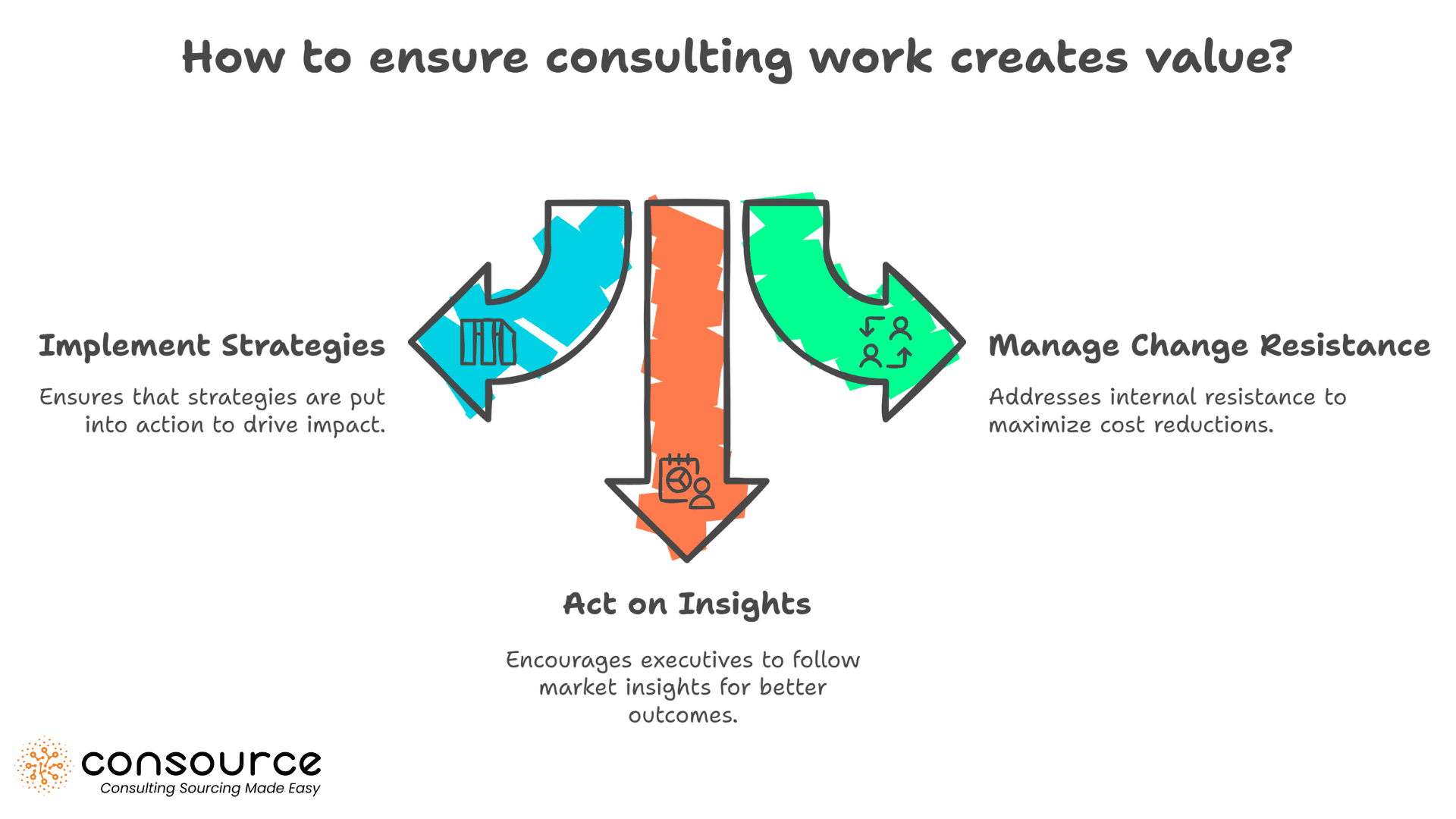Vamos ser honestos: os consultores nem sempre têm a melhor reputação. Você provavelmente já ouviu a piada:
"Um consultor é alguém que tira seu relógio para lhe dizer que horas são."
E se você já trabalhou com consultores antes, talvez tenha se sentido assim. Talvez você tenha se perguntado:
- "Por que estou pagando tão caro por um conselho que já conheço?"
- "Será que realmente precisamos de ajuda externa para isso?"
- "Será que esses consultores estão apenas usando nosso projeto como um campo de treinamento para sua equipe júnior?"
Você não está sozinho. Muitos executivos têm um Relação de amor e ódio com consultores. Por um lado, as empresas de consultoria trazem conhecimento especializado, novas perspectivas e solução estruturada de problemas. Por outro lado, eles podem se sentir como uma necessidade caraespecialmente quando o valor que eles fornecem não está imediatamente claro.
Mas aqui está o problema: A demissão imediata de consultores pode ser um erro dispendioso.
Quando usados corretamente, os consultores não são apenas consultores-Eles são aceleradores. Eles ajudam as empresas Enfrentar desafios complexos, impulsionar a transformação e executar mais rapidamente do que as equipes internas sozinhas. No entanto, obter valor real da consultoria requer a mentalidade, a abordagem e a estratégia de engajamento corretas.
Neste artigo, exploraremos:
- O motivos reais os executivos não gostam de consultores
- O concepções errôneas que alimentam esse ceticismo
- Como fazer Garantir que os compromissos de consultoria ofereçam valor real
- O que os executivos podem fazer para corrigir sua abordagem de consultoria e obter um melhor ROI
No final, talvez você não amor consultores - mas você verá por quê odiá-los completamente pode estar prejudicando seus negócios mais do que você imagina.
Os executivos nem sempre entendem a natureza da consultoria
Aqui está uma verdade que pode surpreendê-lo: Muitos executivos que não gostam de consultores simplesmente não entendem como a consultoria funciona.
Isso não é um insulto, é apenas uma realidade. Alguns executivos nunca trabalharam com consultores, enquanto outros só os viram sendo usados de forma limitada. Sua percepção da consultoria é geralmente moldada por lendas urbanas, experiências ruins passadas ou pouca exposição a determinados tipos de consultores.
Nem toda consultoria é igual
Um dos maiores erros que os executivos cometem é presumir que a empresa está se tornando uma empresa de negócios. todos os consultores são iguais.
Pense nisso: Se você passou sua carreira em OperaçõesVocê deve estar familiarizado com Especialistas em consultoria Lean, otimização de compras ou eficiência da cadeia de suprimentos. Mas quando você se muda para um Função de estratégiaDe repente, você ouve falar de Consultoria de entrada no mercado, estratégia de inovação ou consultores de transformação digital-E tudo isso parece estranho.
Não é de se admirar que alguns executivos sejam céticos. Se você só viu a consultoria de uma perspectiva, pode presumir que os consultores só funcionam dessa forma-o que está longe de ser verdade.
A adoção da consultoria varia de acordo com a região e o setor
A maneira como as empresas usam os consultores também varia drasticamente de acordo com a região e o setor.
- Em alguns regiõesA contratação de consultores é segunda natureza-parte de uma cultura empresarial madura em que o conhecimento externo é uma ferramenta padrão para a tomada de decisões.
- Em outras partes do mundo, a contratação de consultores é vista como um último recurso-um sinal de que a liderança não é forte o suficiente para resolver os problemas internamente.
- Algum setores, como finanças, tecnologia e saúdeAs empresas do setor de seguros e previdência complementar dependem muito da consultoria para obter conhecimento regulatório, estratégico e operacional.
- Outros, como manufatura ou varejoAs empresas de pequeno e médio porte, como a Petrobras, tendem a usar consultores de forma mais seletiva, geralmente para redução de custos ou melhorias de eficiência.
Se um executivo passou a maior parte de sua carreira em um "setor ou região de "baixa consultoria, eles podem ver A consultoria externa é considerada desnecessária, cara demais ou até mesmo um sinal de fraqueza.
Os executivos precisam de uma visão mais ampla da consultoria
A consultoria não se trata apenas de dizer aos líderes o que eles já sabemTrata-se de trazendo novas percepções, práticas recomendadas do setor e metodologias estruturadas para resolver problemas com mais rapidez.
Os melhores executivos não rejeite totalmente os consultores-Eles aprendem a use-os estrategicamente. Entendendo o diferentes tipos de consultoria, quando usá-los e como envolvê-los adequadamente é a chave para transformar o ceticismo em uma vantagem competitiva.
O problema da percepção de valor: os consultores realmente agregam valor?
Todo executivo, em algum momento, já fez a mesma pergunta:
"Esses consultores realmente valem o dinheiro?"
É uma preocupação justa. Afinal de contas, quando uma empresa de consultoria entra com um preço altoSe o dinheiro que recebem vale a pena, os executivos naturalmente se perguntam se estão recebendo o valor do seu dinheiro - ou se estão apenas terceirização de trabalhos que poderiam ser feitos internamente.
E eles não estão sozinhos em seu ceticismo.
Os executivos geralmente acham que poderiam fazer o trabalho internamente
Muitos líderes seniores acreditam que seus equipes próprias poderiam realizar as mesmas tarefas para as quais os consultores são contratados. Eles presumem:
- "Nós já conhecemos nosso negócio melhor do que qualquer consultor jamais poderia conhecer."
- "Se tivéssemos mais tempo, poderíamos resolver isso sozinhos."
- "Por que deveríamos pagar pessoas de fora para nos dizer coisas que já sabemos?"
Na superfície, são preocupações válidas. Se a consultoria fosse apenas sobre replicação do trabalho internoseria, de fato, um desperdício de dinheiro.
Mas aqui está o problema: As melhores empresas de consultoria não se limitam a "fazer o trabalho"-Eles trazem um perspectiva externa, referências do setor e uma abordagem estruturada que as equipes internas geralmente não têm.
Apenas 35% dos executivos veem valor real - por quê?
Mesmo assim, nem todos os contratos de consultoria geram ótimos resultados.
De acordo com Fonte: Pesquisa Global, somente 35% de executivos dizem que as empresas de consultoria com as quais trabalharam agregaram mais valor do que receberam em honorários.
Isso é uma estatística decepcionante-e alimenta a percepção de que os consultores não valem o investimento.
Mas aqui está o verdadeiro problema: alta qualidade nem sempre significa alto valor.
Por que consultoria de alta qualidade nem sempre significa alto valor
Uma empresa de consultoria pode produzir:
Um baralho de estratégias com um belo design
✅ Uma análise rigorosa do mercado
Um roteiro de tecnologia de ponta
E ainda não conseguem criar valor real. Por quê?
Porque O valor não tem a ver com resultados - tem a ver com impacto.
- Se os consultores criarem um ótima estratégia mas a empresa nunca o implementa, há valor zero.
- Se os consultores executarem um programa eficiente de redução de custos mas as equipes internas resistem às mudanças, há valor zero.
- Se os consultores fornecerem percepções profundas do mercado, mas os executivos ignoram suas recomendações, há valor zero.
Em outras palavras, O ROI de consultoria não se refere apenas à qualidade do trabalho, mas também à forma como a organização o utiliza.

💡 O verdadeiro problema não é apenas a consultoria em si, mas a forma como as empresas a compram e gerenciam. Sem a abordagem correta de aquisição, as empresas correm o risco de pagar a mais, subutilizar ou escolher os consultores errados. Ferramentas como Consource.io ajudam a resolver isso, trazendo estrutura, transparência e tomada de decisões baseadas em dados para a aquisição de consultoria
Como os executivos podem garantir que a consultoria agregue valor real
Se os executivos quiserem tirar o máximo proveito dos contratos de consultoria, eles precisam fazer isso:
🔹 Definir claramente o problema antes de contratar consultores (não os use como uma saída fácil).
🔹 Envolver as equipes internas para que eles aceitem as soluções (evitem resistência).
🔹 Responsabilizar os consultores para obter resultados reais, não apenas slides de PowerPoint.
🔹 Escolha os consultores certos para o trabalho (nem todas as empresas são criadas da mesma forma).
Consultando pode ser um poderoso acelerador para o crescimento e a transformação dos negócios - mas somente se os executivos têm um papel ativo em torná-lo valioso.
O fator medo: A contratação de consultores significa que você não pode fazer seu trabalho?
Vamos abordar o elefante na sala de reuniões-Muitos executivos se preocupam secretamente com o fato de que a contratação de consultores faz com que eles pareçam fracos.
Há uma sensação persistente de estigma associados à contratação de especialistas externos. Alguns executivos temem que isso passe a mensagem errada:
- "Se eu trouxer consultores, minha equipe pensará que sou incapaz?"
- "Será que meu chefe vai achar que não estou apto para o trabalho?"
- "Isso significa que estamos fracassando como empresa?"
E quando os consultores são introduzido de forma ruimSe você tem medo de ser um homem de negócios, esses temores não são totalmente infundados. Mas a verdade é que, A contratação de consultores não é um sinal de fracasso - é uma estratégia de aceleração.
De onde vem o estigma
Há uma crença comum (e ultrapassada) de que um líder forte deve ter todas as respostas e nunca precisar de ajuda externa. Mas no atual ambiente de negócios em rápida evolução, essa expectativa não é realista e, francamente, é perigosa.
Pense nos executivos mais bem-sucedidos do mundo. Eles nunca operam sozinhos. Eles se cercam de pessoas:
- Treinadores executivos para aprimorar sua liderança
- Analistas do setor para fornecer inteligência de mercado
- Especialistas em tecnologia para navegar pela transformação digital
- Consultores de estratégia para abrir novas oportunidades
No entanto, quando uma empresa contrata consultores, isso geralmente é enquadrado como um último recurso em vez de um movimento estratégico-o que cria uma resistência desnecessária.
Como o posicionamento interno inadequado dos consultores gera resistência
Quando os consultores são apresentados com o enquadramento errado, as equipes internas podem rapidamente se voltar contra eles.
🚩 A maneira errada de apresentar os consultores:
"Trouxemos consultores para consertar o que está quebrado."
"A liderança não confia na equipe interna para resolver isso."
"Precisamos de especialistas externos porque não temos as habilidades certas."
Esse tipo de mensagem imediatamente torna os funcionários defensivos. Isso cria uma nós contra eles dinâmica em que as equipes veem os consultores como concorrentes em vez de colaboradores.
🔹 A maneira correta de apresentar os consultores:
✅ "Estamos trabalhando com consultores para acelerar o progresso e trazer novas percepções."
"Eles nos ajudarão a aprimorar nossa estratégia e a executar com mais rapidez."
"Esta é uma parceria - nosso conhecimento interno + a perspectiva externa deles."
Quando posicionado corretamente, Os consultores não são uma ameaça - eles são um ativo.
Por que a contratação de consultores é uma estratégia de aceleração, não um fracasso
Contratação de consultores não significa que você não possa fazer o seu trabalho - significa que você é inteligente o suficiente para reconhecer quando o conhecimento externo pode lhe dar uma vantagem.
Os principais executivos não perdem tempo reinventar a roda. Eles aproveitam os melhores recursos, tanto internos quanto externos, para avançar mais rapidamente e alcançar melhores resultados com menos erros.
💡 Pense da seguinte forma:
- Empresas contratam banqueiros de investimento para orientar negócios de bilhões de dólares - não porque seu diretor financeiro seja incompetente, mas porque os banqueiros adicionar experiência e velocidade.
- As empresas usam escritórios de advocacia para questões jurídicas complexas - não porque sua equipe jurídica seja ruim, mas porque especialistas externos trazer uma especialização mais profunda.
- As organizações trazem consultores para enfrentar grandes desafios estratégicos, operacionais ou de transformação - não porque os líderes estejam falhando, mas porque a colaboração cria soluções melhores.
No final do dia, O sucesso não significa fazer tudo sozinho, mas sim tomar as melhores decisões para a empresa.
Consultores x Executivos: Quem está realmente aprendendo com quem?
Uma das maiores frustrações que os executivos têm com os consultores se resume a isso:
👉 "Por que estou pagando caro por consultores juniores que não sabem tanto quanto a minha equipe?"
Essa percepção, muitas vezes chamada de "Problema do "ônibus escolar-está profundamente ligado ao modelo de lucratividade de grandes empresas de consultoria.
Vamos analisar o que realmente está acontecendo aqui e como os executivos podem navegar nesse desafio para obter o conhecimento de que realmente precisam.
Você está pagando para treinar consultores juniores? O problema do "ônibus escolar
A maioria das grandes empresas de consultoria opera em um estrutura piramidal, que significa:
- Parceiros sênior vendem o projeto - Eles são os criadores de oportunidades que conquistam contratos de consultoria de alto custo.
- Os consultores de nível médio gerenciam a execução - Eles garantem que as entregas permaneçam no caminho certo.
- Os consultores juniores fazem a maior parte do trabalho pesado - Os recém-formados em MBA analisam dados, criam relatórios e fazem recomendações.
💰 Por que isso acontece? Porque é altamente lucrativo para empresas de consultoria.
- Os parceiros sênior faturam em $8,000-$15,000 por diamas eles não trabalham em seu projeto diariamente.
- Os consultores juniores faturam em $1600-$2500 por diae eles fazem a maior parte do trabalho.
- A empresa de consultoria maximiza as margens mantendo talentos de baixo custo trabalhando em projetos de alto custo.
Embora esse modelo funciona bem para alguns tipos de projetospode levar a frustração quando os executivos sentem que estão treinando os consultores, e não o contrário.
Nem todas as empresas de consultoria operam dessa maneira
A boa notícia? Nem toda empresa de consultoria segue o mesmo modelo.
✔️ Alguns empresas butique foco na contratação especialistas experientes em vez de jovens analistas.
✔️ Alguns empresas especializadas trazer apenas consultores altamente experientes para projetos de nicho.
✔️ Alguns grandes empresas estruturar equipes de forma diferente, fornecendo envolvimento mais sênior em execução.
O segredo é saber que tipo de empresa contratar para cada tipo de projeto.
Como selecionar os consultores certos para suas necessidades de negócios
Se você Combinar a empresa de consultoria certa com o tipo certo de projetoVocê evitará frustrações e maximizar o valor.
🔹 Quando usar grandes empresas de consultoria (McKinsey, BCG, Bain, etc.)
Melhor para iniciativas estratégicas amplas (expansão do mercado, M&A, transformação digital).
Útil quando você precisa benchmarking e melhores práticas globais.
Eficaz quando a equipe interna é muito esticado para executar.
Risco: Equipes com muitos juniores pode levar a lacunas de conhecimento e resistência interna.
🔹 Quando usar empresas de consultoria especializadas ou boutiques
Melhor para profundo conhecimento do setor (estratégia de IA, otimização da cadeia de suprimentos, conformidade regulamentar).
Ideal quando você quiser consultores sênior que executam diretamente o trabalho.
Frequentemente fornecem serviço mais personalizado e maior flexibilidade.
Risco: Pode ter alcance global limitado em comparação com as grandes empresas.
🔹 Quando usar consultores independentes ou redes de consultoria
Melhor para necessidades altamente especializadas (percepções pontuais de especialistas, análise de nicho de mercado).
Útil quando você precisam apenas de orientação, não de execução completa do projeto.
✅ Frequentemente mais econômico do que as grandes empresas.
Risco: Largura de banda limitada da equipe-você não terá uma equipe completa por trás do seu projeto.
O resultado final: Os consultores devem ser uma extensão da sua equipe, não um fardo
Se você sentir vontade de você está treinando os consultores, e não o contrárioIsso é um sinal de alerta.
Mas isso não significa que A consultoria em si é o problema-Isso significa apenas que você precisa refinar seu processo de seleção para encontrar o ajuste certo.
✔️ Defina claramente seu projeto antes de contratar consultores.
✔️ Pergunte às empresas sobre a composição da equipe logo de início. (Quem está realmente fazendo o trabalho?)
✔️ Priorizar a experiência em detrimento da marca quando necessário.
✔️ Não se limite a aceitar o modelo padrão de consultoria - negocie para obter o envolvimento sênior.
As melhores relações de consultoria acontecem quando os executivos assumem um papel ativo na escolha dos parceiros certos - aqueles que realmente agregam valor em vez de apenas preencher slides.
Grande estratégia, execução zero? A armadilha da consultoria
Os consultores adoram entregar estratégias grandes e ousadas. Mas quando se trata de realmente fazendo-os acontecerEm geral, as coisas desandam.
Os executivos frequentemente reclamam que os consultores fornecem:
🚀 Ideias visionárias-mas sem um roteiro claro.
📊 Lindos decks de PowerPoint-mas nenhum plano de implementação real.
💡 Modelos e estruturas complexasmas nenhuma medida prática para executá-las.
O resultado? Uma estratégia que parece ótima na teoria mas nunca sai do papel.
Isso é o que chamamos de a lacuna de execução-e é uma das maiores frustrações que os executivos têm com as empresas de consultoria.
Estratégia vs. execução: Por que uma empresa não pode fazer tudo
Um dos maiores erros que as empresas cometem é supondo que a mesma empresa de consultoria deva cuidar tanto da elaboração quanto da execução da estratégia.
Mas aqui está a realidade:
✔️ Algumas empresas Excelência na elaboração de estratégias-mas tem dificuldades na execução.
✔️ Outros são excelente em implementação-mas não têm a visão de uma estratégia de alto nível.
✔️ E muito poucas empresas realmente dominar ambos.
💰 Por que isso é importante? Porque o preço não é o mesmo.
- Um alto padrão empresa de estratégia cobrará uma prêmio para pensar em termos gerais, mas talvez não sejam a melhor opção para arregaçar as mangas e fazer o trabalho.
- Por outro lado, um empresa com foco na execução pode ser excelente em transformando a estratégia em ação-mas não têm o conhecimento profundo necessário para projetar um estratégia inovadora e revolucionária em primeiro lugar.
Empresas deve ser cauteloso antes de contratar a mesma empresa para ambos fases. Embora algumas empresas ofereçam ambos os serviços, eles geralmente usam equipes diferentesE a experiência que torna alguém excelente em projetar uma estratégia não é a mesma que torna alguém excelente em executá-la.
💡 Até mesmo as grandes empresas reconhecem essa lacuna. Algumas até criaram braços de implementação dedicados, separados de suas divisões de estratégia, para lidar com a execução de forma diferente.
Como garantir que os consultores forneçam soluções práticas
Para evitar a lacuna de execução, A clareza é tudo.
Veja como garantir que os consultores não apenas forneçam ideias, mas que realmente ajudem a transformá-las em resultados:
✅ Esclareça as expectativas desde o início.
- Definir claramente O que você espera dos entregáveis antes de assinar o contrato.
- Pergunte: "Estamos recebendo uma estratégia de alto nível, um plano de execução ou suporte prático à implementação?"
✅ Pressione por um plano de ação concreto.
- Uma estratégia sem um roteiro de execução é inútil.
- Certifique-se de que os consultores delinear as próximas etapas, responsabilidades e cronogramas acionáveis.
✅ Não presuma uma empresa de tamanho único.
- Algumas empresas se destacam em estratégia, outros em execução-Saiba a diferença.
- Se sua empresa parcerias com vários consultores para diferentes fases, o que é completamente normal.
✅ Pergunte sobre parcerias de implementação.
- Mesmo as grandes empresas parceria com outros especialistas para execução.
- Assegurar que seus consultores ou têm fortes capacidades de execução ou pode recomendar parceiros confiáveis que o fazem.
O resultado final: Estratégia sem execução é apenas um pensamento positivo
No final do dia, grandes ideias não geram resultados - a execução sim.
Se os executivos quiserem impacto real de consultores, eles devem:
🔹 Compreender os verdadeiros pontos fortes da empresa-Eles são estrategistas ou executores?
🔹 Exigir resultados com foco na execução-e não apenas apresentações.
🔹 Estar aberto a trabalhar com várias empresas-em vez de obrigar a pessoa a fazer tudo.
Porque em consultoria, A experiência não é apenas uma palavra da moda - é a diferença entre o sucesso e o fracasso.
Como mudar a mentalidade dos executivos e obter um ROI real dos consultores
Os executivos não desgostam dos consultores só porque eles são caros. A verdadeira questão geralmente se resume a dois problemas fundamentais:
1️⃣ Percepções negativas sobre consultoria - Muitos executivos consideram os consultores desnecessários, caros demais ou ineficazes.
2️⃣ Aquisição e contratação de consultoria deficiente - As empresas não conseguem definir objetivos claros, selecionar as empresas certas ou medir o ROI adequadamente.
Quando esses dois problemas não são controlados, os compromissos de consultoria se tornam frustrante, dispendioso e não satisfatório.
Mas quando os executivos mudar sua mentalidade e envolver os consultores estrategicamente, eles podem maximizar o ROI e liberar o impacto real nos negócios.
Medindo o valor real da consultoria: ROI tangível vs. intangível
Os executivos geralmente têm dificuldades para medir o sucesso da consultoria porque O valor nem sempre é óbvio de imediato.
🔹 Valor tangível (fácil de medir):
Economia de custos (por exemplo, otimização de compras, eficiências operacionais)
Crescimento da receita (por exemplo, entrada em novos mercados, estratégias de vendas aprimoradas)
Melhorias no processo (por exemplo, automação, transformação digital)
🔹 Valor intangível (mais difícil de medir, mas igualmente importante):
Melhor tomada de decisões (por exemplo, insights orientados por dados, mitigação de riscos)
Desenvolvimento de liderança (por exemplo, coaching executivo, capacitação de equipes)
Alinhamento estratégico (por exemplo, prioridades comerciais mais claras, visão unificada)
💡 A correção: Antes de contratar consultores, definir como o sucesso será medido. Alinhar as expectativas entre as equipes internas e os consultores para que resultados tangíveis e intangíveis são reconhecidos.
Práticas recomendadas para o envolvimento da consultoria e o alinhamento interno
Quando os executivos reformular sua percepção sobre os consultores e definir métricas claras de sucesso, a próxima etapa é envolver os consultores da maneira correta.
✔️ Comece com um problema bem definido.
- Não recorra a consultores apenas porque "algo não está funcionando".
- Identificar os desafio específico e quais conhecimentos são necessários.
✔️ Escolha o tipo certo de consultor para o trabalho.
- Isso é um estratégia problema ou um execução problema?
- Será que um empresa boutique, grande empresa, ou especialista independente é o mais adequado?
✔️ Garantir que as equipes internas estejam alinhadas antes da chegada dos consultores.
- Nada mata um projeto de consultoria mais rapidamente do que a resistência interna.
- Comunicar que os consultores estão aqui para acelerar, e não substituir, os esforços internos.
✔️ Negocie os resultados, não apenas as horas.
- Em vez de se concentrar no número de horas de consultoria, concentre-se em o que eles entregarão.
- Defina marcos e responsabilize os consultores pelos resultados.
✔️ Não prorrogue contratos cegamente - avalie os resultados primeiro.
- A consultoria não deve se tornar um fixação permanente-deve resolver um problema e sair.
- Avalie regularmente se os consultores ainda estão agregando valor ou se o trabalho deve ser feito internamente.
O resultado final: A consultoria funciona quando é feita corretamente
Contratação de consultores não é um fracasso-é um ferramenta para aceleração.
Executivos que entender como envolver os consultores de forma eficaz:
🔹 Medir o valor tangível e intangível-e não apenas o custo.
🔹 Definir critérios claros de sucesso antes de iniciar um projeto.
🔹 Alinhar suas equipes internas para garantir que os consultores sejam usados estrategicamente.
Quando bem feita, a consultoria não é apenas um despesa-é um investimento em um crescimento mais inteligente e rápido dos negócios.
Repensando a consultoria - da frustração à vantagem competitiva
É perfeitamente razoável que os executivos sentir-se frustrado com consultores. Eles podem ser caros, às vezes prometem demais e nem sempre entregam o valor esperado.
Mas aqui está a realidade: Os consultores não são o problema - o problema é como eles estão engajados.
A chave para Obtendo valor real da consultoria não se trata apenas de gastando menos ou evitar totalmente os consultoresTrata-se de aquisição, avaliação e integração mais inteligentes de serviços de consultoria.
Executivos que sabem como comprar, usar e gerenciar consultoria de forma estratégica transformá-lo em um centro de custos em um acelerador de negócios.
Mas gerenciar manualmente os compromissos de consultoria...rastreamento de contratos, comparação de empresas, avaliação de desempenho-pode ser esmagadora. É aí que entra a tecnologia.
Conheça a Consource.io: A maneira mais inteligente de comprar e gerenciar consultoria
Se você quiser Maximizar o ROI da consultoriavocê precisa de um abordagem estruturada e orientada por dados-e é exatamente isso que Consource.io fornece.
✅ Encontre os consultores certos com mais rapidez-com recomendações examinadas com base na experiência e no desempenho anterior.
✅ Acompanhar e comparar os compromissos de consultoria-para que você saiba quais empresas oferecem valor real.
✅ Certifique-se de que está pagando o preço certo-com referências de custo transparentes.
✅ Simplifique a aquisição e o gerenciamento-Assim, a consultoria gera impacto, não dores de cabeça.
Com Consource.io, executivos assumir o controle de sua estratégia de consultoria-garantir que cada dólar gasto gera resultados mensuráveis.
Os executivos mais inteligentes não apenas contratam consultores - eles os gerenciam estrategicamente.
A questão não é se devemos usar consultores, mas como usá-los melhor.
🚀 Você está pronto para começar a fazer a consultoria trabalhar para você? Dê uma olhada em Consource.io e transforme a maneira como você compra e gerencia a consultoria hoje.









0 comentários